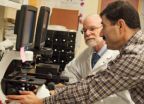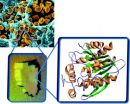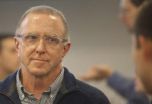(Press-News.org) ANN ARBOR, Mich. — New research from the University of Michigan Comprehensive Cancer Center and Georgia Regents University finds that a protein that fuels an inflammatory pathway does not turn off in breast cancer, resulting in an increase in cancer stem cells. This provides a potential target for treating triple negative breast cancer, the most aggressive form of the disease.
The researchers identified a protein, SOCS3, that is highly expressed in normal cells but undetectable in triple-negative breast cancer. They showed that this protein is degraded in cancers, blocking the cellular off-switch of a feedback loop involving the inflammatory protein interleukin 6, IL6. When the switch does not get turned off, it enables cancer stem cells to grow.
"We have known for a long time known that there are important links between inflammation and cancer, including similar pathways that regulate normal and cancer stem cells," says study author Max S. Wicha, M.D., distinguished professor of oncology and director of the U-M Comprehensive Cancer Center.
"This work helps explain why these pathways shut off in normal tissues after injury but remain active in cancers, resulting in an increase in cancer stem cells. Furthermore, they suggest that blocking these inflammatory loops may be a means of targeting cancer stem cells, improving patient outcome," he says.
The study appears in the Nature journal Oncogene.
Currently, there are no molecularly targeted therapies aimed at triple-negative breast cancer, which is a type of cancer negative for estrogen receptor, progesterone receptor and the HER2 protein – all key targets for current therapies. Patients with this form of disease tend to have worse outcomes.
The researchers tested a drug, bortezomib, in mouse models of triple-negative breast cancer and found that it stops the protein degradation, resulting in the inflammatory loop shutting off, which reduces the cancer stem cells, thereby blocking metastasis. Bortezomib is currently approved for treatment of the blood cancer multiple myeloma.
This team previously showed that IL6 can stimulate breast cancer stem cells in HER2-positive breast cancers and they are designing a clinical trial which uses an IL6 blocker. The new research suggests that adding bortezomib to the IL6 inhibitor may be a way to target stem cells in triple-negative breast cancer.
"Now that we unveiled how inflammation is regulated in triple-negative breast cancer, we expect that our studies can be translated into the clinic. The drugs used to block these chemical messengers are already approved for the treatment of rheumatoid arthritis and other inflammation-related diseases, which should facilitate their use in cancer," says study author Hasan Korkaya, Ph.D., assistant professor at the Georgia Regents University Cancer Center.
More laboratory testing is needed before a clinical trial can begin. The researchers also suspect that this pathway may apply to other cancers as well and are investigating that further.
Breast cancer statistics: 235,030 Americans will be diagnosed with breast cancer this year and 40,430 will die from the disease, according to the American Cancer Society
INFORMATION:
Additional authors: G. Kim, M. Ouzounova, A.A. Quraishi, A. Davis, N. Tawakkol, S.G. Clouthier, F. Malik, A.K. Paulson, R.C. D'Angelo, S. Korkaya, T.L. Baker, E.S. Esen, A. Prat, S. Liu, C.G. Kleer, D.G. Thomas
Funding: National Cancer Institute grants CA101860 and CA129765, Breast Cancer Research Foundation, Susan G. Komen, Georgia Regents University Cancer Center, A. Alfred Taubman Research Institute
Disclosure: Wicha has financial holdings and is a scientific adviser for OncoMed Pharmaceuticals, is a scientific adviser for Verastem, Paganini and MedImmune and receives research support from Dompe Pharmaceuticals and MedImmune
Reference: Oncogene, doi: 10.1038/onc.2014.4
Resources:
U-M Cancer AnswerLine, 800-865-1125
U-M Comprehensive Cancer Center, http://www.mcancer.org
Clinical trials at U-M, http://www.mcancer.org/clinicaltrials
New finding points to potential options for attacking stem cells in triple-negative breast cancer
Study sheds light on link between cancer stem cells and inflammation
2014-02-17
ELSE PRESS RELEASES FROM THIS DATE:
Religious and scientific communities may be less combative than commonly portrayed
2014-02-17
One of the largest surveys of American views on religion and science suggests that the religious and scientific communities may be less combative than is commonly portrayed in the media and in politics.
Only 27 percent of those surveyed said that they viewed science and religion as being in conflict with each other, with about equal percentages of those people "siding with either religion or science," said Rice University sociologist Elaine Howard Ecklund at the AAAS Annual Meeting. The survey was commissioned by the AAAS Dialogue on Science, Ethics and Religion (DoSER) ...
Uncovering the secrets of tularemia, the 'rabbit fever'
2014-02-17
WASHINGTON D.C. Feb. 16, 2014 -- Tularemia, aka "rabbit fever," is endemic in the northeastern United States, and is considered to be a significant risk to biosecurity -- much like anthrax or smallpox -- because it has already been weaponized in various regions of the world.
At the 58th Annual Biophysical Society Meeting, which takes place Feb. 15-19, 2014, in San Francisco, Calif., Geoffrey K. Feld, a Postdoctoral researcher in the Physical & Life Sciences Directorate at Lawrence Livermore National Laboratory (LLNL), will describe his work to uncover the secrets of the ...
Bacterial superbug protein structure solved
2014-02-17
WASHINGTON D.C. Feb. 16, 2014 -- A research team from Vanderbilt University Medical Center in Nashville, Tenn., is the first to decipher the 3-D structure of a protein that confers antibiotic resistance from one of the most worrisome disease agents: a strain of bacteria called methicillin-resistant Staphylococcus aureus (MRSA), which can cause skin and other infections. The Vanderbilt team's findings may be an important step in combatting the MRSA public health threat over the next 5 to 10 years.
By deciphering the shape of a key S. aureus protein -- an enzyme called ...
Harvesting light, the single-molecule way
2014-02-17
WASHINGTON D.C. Feb. 16, 2014 -- New insights into one of the molecular mechanisms behind light harvesting, the process that enables photosynthetic organisms to thrive, even as weather conditions change from full sunlight to deep cloud cover, will be presented at the 58th Annual Biophysical Society Meeting, taking place in San Francisco from Feb. 15-19.
At the meeting, Hsiang-Yu Yang, a graduate student, and Gabriela Schlau-Cohen, a postdoc in W.E. Moerner's research group at Stanford University, will describe how probing these natural systems at the single molecule level ...
Deep ocean needs policy, stewardship where it never existed
2014-02-17
BEAUFORT, N.C. -- Technological advances have made the extraction of deep sea mineral and precious metal deposits feasible, and the dwindling supply of land-based materials creates compelling economic incentives for deep sea industrialization. But at what cost?
“We’re really in the dark when it comes to the ecology of the deep sea," said Linwood Pendleton, director of the Ocean and Coastal Policy Program at the Nicholas Institute for Environmental Policy Solutions at Duke University. "We know a lot about a few places, but nobody is dealing with the deep sea as a whole, ...
Obesity in Samoa: A global harbinger?
2014-02-17
PROVIDENCE, R.I. [Brown University] — The South Pacific archipelago of Samoa and American Samoa harbors a global health mystery that may seem both remote and extreme but could foretell trends in obesity and related conditions across much of the developing world.
About three-quarters of the U.S. territory's adult population is obese, the highest rate in the world with independent Samoa quickly catching up. Rates of type 2 diabetes top one in five and a recent study found that the elevated obesity rates are present even in newborns.
This pandemic began only a few decades ...
Global perspectives on human biology and health
2014-02-17
CHICAGO --- Three anthropology professors from the Weinberg College of Arts and Sciences at Northwestern University will highlight recent research in biological anthropology Sunday, Feb. 16 at the annual meeting of the American Association for the Advancement of Science (AAAS) in Chicago.
The presentations, part of the symposium "Comparative Advantage: Global Perspectives on Human Biology and Health" will be held from 1:30 to 4:30 p.m. in Crystal Ballroom A at the Hyatt Regency Chicago.
Christopher Kuzawa, professor of anthropology and faculty fellow at the Institute ...
Nanoelectronics key to advances in renewable energy
2014-02-17
TEMPE, Ariz. – Nanoscale technology looks promising as a major contributor to advancements needed to fulfill the potential of emerging sources of clean, renewable energy.
Progress in the comparatively new area of nanoelectronics in particular could be the basis for new manufacturing processes and devices to make renewable energy systems and technologies more efficient and cost-effective.
Stephen Goodnick will focus on what nanoelectronics advances could do to help push the performance of solar energy systems to the next level in his talk at the 2014 annual meeting of ...
Epigenetic regulation required to ensure correct number of chromosomes
2014-02-17
Abnormal number of chromosomes is often associated with cancer development. In a new study published in the journal Nature Structural and Molecular Biology researchers at Karolinska Institutet in Sweden have shown that a subtle epigenetic change plays an important role in the correct segregation of chromosomes.
Normally when a cell divides, the chromosomes are segregated equally to two daughter cells. However, tumour cells frequently have either too few or too many chromosomes, leading to the incorrect expression of a number of genes. When a cell is about to divide, the ...
New eye layer has possible link to glaucoma
2014-02-17
A new layer in the human cornea — discovered by researchers at The University of Nottingham
last year — plays a vital role in the structure of the tissue that controls the flow of fluid
from the eye, research has shown. The findings, published in a paper in the British
Journal of Ophthalmology, could shed new light on glaucoma, a devastating disease caused by
defective drainage of fluid from the eye and the world's second leading cause of blindness.
The latest research shows that the new layer, dubbed Dua's Layer after the academic Professor
Harminder Dua who ...
LAST 30 PRESS RELEASES:
Superradiant spins show teamwork at the quantum scale
Cleveland Clinic Research links tumor bacteria to immunotherapy resistance in head and neck cancer
First Editorial of 2026: Resisting AI slop
Joint ground- and space-based observations reveal Saturn-mass rogue planet
Inheritable genetic variant offers protection against blood cancer risk and progression
Pigs settled Pacific islands alongside early human voyagers
A Coral reef’s daily pulse reshapes microbes in surrounding waters
EAST Tokamak experiments exceed plasma density limit, offering new approach to fusion ignition
Groundbreaking discovery reveals Africa’s oldest cremation pyre and complex ritual practices
First breathing ‘lung-on-chip’ developed using genetically identical cells
How people moved pigs across the Pacific
Interaction of climate change and human activity and its impact on plant diversity in Qinghai-Tibet plateau
From addressing uncertainty to national strategy: an interpretation of Professor Lim Siong Guan’s views
Clinical trials on AI language model use in digestive healthcare
Scientists improve robotic visual–inertial trajectory localization accuracy using cross-modal interaction and selection techniques
Correlation between cancer cachexia and immune-related adverse events in HCC
Human adipose tissue: a new source for functional organoids
Metro lines double as freight highways during off-peak hours, Beijing study shows
Biomedical functions and applications of nanomaterials in tumor diagnosis and treatment: perspectives from ophthalmic oncology
3D imaging unveils how passivation improves perovskite solar cell performance
Enriching framework Al sites in 8-membered rings of Cu-SSZ-39 zeolite to enhance low-temperature ammonia selective catalytic reduction performance
AI-powered RNA drug development: a new frontier in therapeutics
Decoupling the HOR enhancement on PtRu: Dynamically matching interfacial water to reaction coordinates
Sulfur isn’t poisonous when it synergistically acts with phosphine in olefins hydroformylation
URI researchers uncover molecular mechanisms behind speciation in corals
Chitin based carbon aerogel offers a cleaner way to store thermal energy
Tracing hidden sources of nitrate pollution in rapidly changing rural urban landscapes
Viruses on plastic pollution may quietly accelerate the spread of antibiotic resistance
Three UH Rainbow Babies & Children’s faculty elected to prestigious American Pediatric Society
Tunnel resilience models unveiled to aid post-earthquake recovery
[Press-News.org] New finding points to potential options for attacking stem cells in triple-negative breast cancerStudy sheds light on link between cancer stem cells and inflammation




